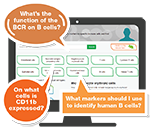Spin Break: Podcasts
s
s
Interactive Tool

Human and mouse immune cell marker databases. All the facts at your fingertips from cell lineage to marker proteins, discover for yourself.

Overview
Keep your mind active during lab breaks, or warm-up for the day ahead on your commute, with short podcasts from Bio-Rad.
Antibody Advice
Knowing how to select, handle, and work with your antibodies will aid you in getting the most reliable results from your experiment. Listen to our Antibody Advice podcast series to help you get results you can feel confident in.
How to choose a primary antibody
Choosing a primary antibody is an important factor for the success of your experiment. This podcast will walk you through some general principles you should follow to ensure that you get the best product for your needs.
How to choose a secondary antibody
Finding the best secondary antibody to pair with your chosen primary antibody opens up an array of sometimes confusing choices. A wrong decision at this point can result in ambiguous data, incorrect data, or even no data. In this podcast, we will discuss the key considerations to keep in mind when choosing the appropriate secondary antibody.
Handling your antibody
Improper storage and handling of an antibody can result in loss of activity and degradation of the antibody. In this podcast, we will be covering the best methods for handling and storing your antibodies to allow you to get the most out of them in your experiments.
Essentials of Flow Cytometry
Do your research before setting up your experiments by listening to our short podcasts on the essentials of flow cytometry. Each podcast features expert advice from the Bio-Rad Antibody team on important steps to improve your flow cytometry results.
The importance of cell frequency
Do you know the frequency of your population of interest? Learn about the impact of cell frequency on flow cytometry experiments and how you can optimize your conditions to improve detection of rare populations in this podcast.
Viability dyes and how to exclude dead cells from your analysis
Careful sample preparation can minimize the number of dead cells in your sample, but how do you know that you are not sorting dead cells? In this podcast, you will learn how to use the different types of viability dyes and exclude dead cells from flow cytometry assays.
Sample preparation: Tips for blood samples
In this podcast, learn how to prepare blood samples ready for flow cytometry experiments with our top three tips.
Understanding Cell Cycle Regulation
Keep your research moving forwards in your lab breaks by listening to our short podcasts on cell cycle regulation. Each podcast features advice from the Bio-Rad Antibody team, on an area of cell cycle regulation, to help you improve your assays.
Studying SUMOylation?
Check out our podcast on SUMOylation, including our tips to help you study this post translational modification. Spend your experimental break wisely and get some science on the go in less than 5 minutes.
Studying cell proliferation
A number of different assay types exist for studying cell proliferation but which technique is best for you? In this podcast, Bio-Rad reviews three popular methods: using thymidine analogs, quantifying DNA content, and detecting cell proliferation markers.
BrdU in adult neurogenesis research
Check out the podcast version of our two blog articles. You will learn how BrdU was established as a popular tool for neurogenesis research as well as gain insight into the latest BrdU related findings. Finally, you will go away with 5 practical tips for controlling your BrdU labeling experiments.
Insights into Therapeutic Antibody Development
Monoclonal antibodies are used as drugs to treat a range of conditions from autoimmune disorders to cancer. These short podcasts explore the development of human drugs and how anti-idiotypic antibodies support this process.
Monoclonal antibodies as targeted cancer therapy
This podcast discusses monoclonal antibodies as cancer therapies, how they work, and their advantages compared with other cancer treatments.
The benefits of therapeutic drug monitoring
In this podcast learn about therapeutic drug monitoring and why we need to monitor drug levels for some patients.
Challenges for the bioanalysis of CAR-T cells
Bio-Rad antibody expert, Michael Schwenkert, talks about the challenges for bioanalysis of CAR-T cells and how they can be addressed by the design and generation of customized anti-idiotypic antibodies.
The logic behind antibody drug names
Have you noticed that therapeutic antibodies have complex and often unpronounceable names? It probably won’t surprise you to hear that there is a logic behind these names which convey information about the type of drug and its mechanism of action.
Fundamentals of Secondary Antibodies
Understanding secondary detection is essential for getting the right result but it is often overlooked, or neglected leading to poor results. Listen to our secondary antibody podcast series to improve your experiments by learning how to choose and use these critical detection reagents.
Tips for choosing secondary antibodies
This podcast covers the main factors that impact which secondary antibodies you should use in your experiments for the best results.
Understanding cross-adsorbed antibodies
Could cross-adsorbed secondary antibodies reduce your background and improve your results? Learn about cross-adsorption and how it removes undesirable cross-reactivity.
Does binding site matter?
Do you know where on the primary antibody your secondary antibody binds? Learn why it can i mpact your results and how to choose an appropriate secondary antibody.
Considerations for multiplexing experiments
This podcast highlights five important things to consider when you are selecting secondary antibodies for multiplexing experiments.




